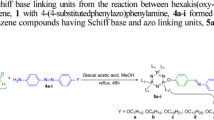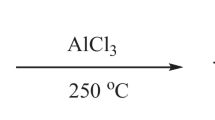Abstract
A novel star-shaped cyclotriphosphazene substituted by glycinomethylesterphenoxy and its intermediates are synthesized from hexachlorocyclotriphosphazene (HCCP). The structures are characterized by 1H NMR, 13C NMR, 31P NMR, FTIR and elemental analysis. Their thermal properties are clarified by thermogravimetric analysis (TGA), differential scanning calorimentry (DSC) and FTIR, while hydrolytic degradation behaviour is studied with UV-vis spectrophotometer and by measuring the weight loss, and the phosphorus content of residue. According to hydrolysis behaviour of hexa[p-(carbonylglycinomethylester)phenoxy]cyclotriphosphazene (HGPCP) under different conditions, it is easy to hydrolyze in hydrochloric acid (pH 1.0) than in phosphate buffer (pH 7.4) at 37°C. And the sample hydrolytic degradation still remains at the stage of side groups’ break. The TGA data show that the thermal stability of the hexa[p-(aldehyde)phenoxy]cyclotriphosphazene (HAPCP), hexa[p-(carboxyl) phenoxy]cyclotriphosphazene (HCPCP) and HGPCP is so high that their char residues are 75%, 47% and 47% at 800°C, respectively, probably due to cross-linking between molecules.
Similar content being viewed by others
References
Mario G, Roberta B, Roger D J. Fluorinated polyphosphazenes: A survey. J Inorg Organomet Polym, 2004, 14(1): 1–23
DAL H, Suzen Y. Phosphorus-nitrogen compounds: Synthesis and spectral investigations on new spiro-cyclic phosphazene derivatives. Spectrochim Acta, Part A, 2007, 67(5): 1392–1397
Kupka T, Pasterny K, Pasterna G, Brandt K. From planar to nonplanar cyclotriphosphazenes. J Mol Struct, 2008, 866(1–3): 21–26
Zhu Y, Huang X B, Fu J W, Wang G, Tang X Z. Morphology control between microspheres and nanofibers by solvent-induced approach based on crosslinked phosphazene-containing materials. Mater Sci Eng, B, 2008, 153(1–3): 62–65
Fei S T, Wood R M, David K L, David A S, Chang H L, Allcock H R. Inorganic-organic hybrid polymers with pendent sulfonated cyclic phosphazene side groups as potential proton conductive materials for direct methanol fuel cells. J Membr Sci, 2008, 320(1–2): 206–214
Allcock H R, Wood R M. Design and synthesis of ion-conductive polyphosphazenes for fuel cell applications: review. J Polym Sci, Part B: Polym Phys, 2006, 44(16): 2358–2368
Giavaresi G, Tschon M, Borsari V, Daly J H, Liggat J J, Fini M, Bonazzi V, Nicolini A, Carpi A, Morra M, Cassinelli C, Giardino R. New polymers for drug delivery systems in orthopaedics: In vivo biocompatibility evaluation. Biomed Pharmacother, 2004, 58(8): 411–417
Jun Y J, Kim J I, Jun M J, Sohn Y S. Selective tumor targeting by enhanced permeability and retention effect. synthesis and antitumor activity of polyphosphazene-platinum (-) conjugates. J Inorg Biochem, 2005, 99(8): 1593–1601
Yu J Y, Jun Y J, Jang S H, Lee H J, Sohn Y S. Nanoparticulate platinum (-) anticancer drug: Synthesis and characterization of amphiphilic cyclotriphosphazene-platinum (-) conjugates. J Inorg Biochem, 2007, 101(11–12): 1931–1936
Ozturk A I, Yilmaz O, Kirbag S, Arslan M. The synthesis and characterization of cycloalkoxy-linear phosphazenes. Cell Biochem Funct, 2003, 178(10): 2097–2105
George M, Ponn B, Henry S, Hugh T, Richard Y, Bryan R, Andrianov A K, Babiuk L A. Poly[di(sodium carboxylatoethylphenoxy) phosphazene] (pcep) is a potent enhancer of mixed th1/th2 immune responses in mice immunized with influenza virus antigens. Vaccine, 2007, 25(7): 1204–1213
Yilmaz O, Aslan F, Ozturk A I, Vanli N, Kirbag S, Arslan M. Antimicrobial and biological effects of n-diphenylphosphoryl-p-triphenylmonophosphazene-II and di(o-tolyl)phosphoryl-p-tri(o-tolyl)monophosphazene-III on bacterial and yeast cells. Bioorg Chem, 2002, 30(5): 303–314
Liu Y Q, Zhao G Z. Study on the properties of microcapsulated chlorocyclophosphazene polypropylene composites. Chin J Chem Eng, 2007, 15(3): 429–432
Allcock H R. New approaches to hybrid polymers that contain phosphazene rings. J Inorg Organomet Polym, 2007, 17(2): 349–359
El-Amin S F, Kwon M S, Starnes T, Allcock H R, Laurencin C T. The biocompatibility of biodegradable glycine containing polyphosphazenes: A comparative study in bone. J Inorg Organomet Polym, 2006, 16(4): 387–396
Jin K K, Udaya S T, Rita S, Youn S S. A macromolecular prodrug of doxorubicin conjugated to a biodegradable cyclotriphosphazene bearing a tetrapeptide. Bioorg Med Chem Lett, 2005, 15(15): 3576–3579
Wang L, Ye Y, Zhong S B, Zhao Y F. Polydentate cyclotriphosphazene ligands: Design, synthesis and bioactivity. Chin Chem Lett, 2009, 20(1): 58–61
Menemse G, Altug G. Synthesis, characterization, in vitro degradation and cytotoxicity of poly[bis(ethyl 4-aminobutyro)phosphazene]. React Funct Polym, 2002, 52(2): 71–80
Cui Y J, Zhao X, Tang Xi Z, Luo Y P. Novel micro-crosslinked poly(organophosphazenes) with improved mechanical properties and controllable degradation rate as potential biodegradable matrix. Biomaterials, 2004, 25(3): 451–457
Yin L, Huang X B, Tang X Z. Synthesis, characterization and hydrolytic degradation of linear and crosslinked poly[(glycino ethyl ester)(allyl amino)phosphazene]. Polym Degrad Stab, 2007, 92(5): 795–801
Udaya S T, Sun H M, Hye Y K, Yong J J, Byong M K, Yong M P, Byeongmoon J, Youn S S. Thermosensitive and biocompatible cyclotriphosphazene micelles. J Control Release, 2007, 119(1): 34–40
Fantin G, Fogagnolo M, Medici A, Pedrini P, Gleria M, Minto F. Photosensitive phosphazene substrates: Synthesis and characterization. Gazz Chim Ital, 1997, 127(5): 287–292
Yuan W Z, Tang X Z, Huang X B, Zheng S X. Synthesis, characterization and thermal properties of hexaarmed star-shaped poly(ε-caprolactone)-b-poly(D,L-lactide-co-glycolide) initiated with hydroxyl-terminated cyclotriphosphazene. Polymer, 2005, 46(5): 1701–1707
Yin R H, Xue L G, Yu Z Z. Determination of phosphorous content in electroless ni-p coating by quinoline phosphomolybdate gravimetric method (in Chinese). Mater Protection, 2007, 40(4): 67–69
Allcock H R, Fuller H J, Matsumera K. Hydrolysis pathways for aminophosphazenes. Inorg Chem, 1982, 21: 515–521
Allcock H R, Pucher S R, Scopelianos A G. Poly [(amino acid ester) phosphazenes]: Synthesis, crystallinity and hydrolytic sensitivity in solution and solid state. Macromolecules, 1994, 27: 1071–1075
Cui Y J, Ma X M, Tang X Z, Luo Y P. Synthesis, characterization, and thermal stability of star-shaped poly(ε-caprolactone) with phosphazene core. Eur Polym J, 2004, 40(2): 299–305
Author information
Authors and Affiliations
Corresponding author
Additional information
Supported by the National Natural Science Foundation of China (Grant No. 20774016), and Heilongjiang Science Fund for Distinguished Young Scholars (Grant No. JC 04-06)
Rights and permissions
About this article
Cite this article
Bing, B., Li, B. Synthesis, thermal property and hydrolytic degradation of a novel star-shaped hexa[p-(carbonylglycinomethylester)phenoxy]cyclotriphosphazene. Sci. China Ser. B-Chem. 52, 2186–2194 (2009). https://doi.org/10.1007/s11426-009-0159-z
Received:
Accepted:
Published:
Issue Date:
DOI: https://doi.org/10.1007/s11426-009-0159-z




